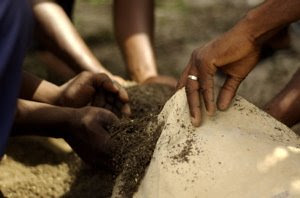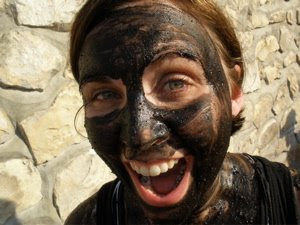As you can imagine, its difficult to truly describe a typical day here. With the whirling of people and energy and projects and colors, each day is unexpected and unique. That being said, Eric and I are both getting into a bit of a routine. And, for those that know me well, you know how grateful I am for any bits of routine I can get my little hands on.
5:00am. The sun and the animals begin to wake. Because of the lack of electricity, the days here seem to truly start with the light. The roosters make sure every knows its time to get up, and the noise of people and animals beginning their day swirl around the little volunteer house.
6:15-30am. On good days, I join some of the AMURT staff at the village pool to start the day off with a swim. The village of Source Chaudes is named after the hot springs here. Over the years, these springs have been funneled into a number of pools, washing places, and gathering spaces. One of the pools (my favorite) is made of cement, with “I love you” painted in English on the bottom. It is a constant flow of beautiful, clear, warm water … and is a lovely way to start the day.
8:00am Breakfast. Eric and I eat breakfast with a number of AMURT medical staff at a house on the other side of the village. Our breakfast rotation is: corn meal with spices/spinach, boiled bananas and onions with sauce and spaghetti. We’re (surprisingly!) getting used to spaghetti for breakfast. Its quite delicious.
Sidenote: Thursdays and Saturdays are market days, so on both days we stop in the market on the way back from breakfast. The BIG market of the week is on Thursday. People begin traveling to Source Chaudes and setting up their sales area on Wednesday night. And then on Thursday, the people come from all around to buy and sell for the coming week. Official employment in Source Chaudes is nearly 0%. The majority of the money exhange that does exist happens between individuals and families on market day.
8:45am Work begins. The AMURT office used to be a big barn - it has cement brick walls, a metal roof and cement floors. One room is split into a storage space and a common eating space (with a kitchen), the other room is an office. The building has solar panels on the roof that provide for the only electricity access in the village. Work for Eric and I varies every day. Its looking like I will spend most of my time in the office, with occasional visits to project sites - my main tasks here are to develop basic org materials for AMURT (a brochure, a power-point, a newsletter template, a handbook describing the history and current program of each project – and to assist them in developing a formalized volunteer program. Truly right up my alley.
12pm (m, w, f) Creole – English Exchange. Three times a week, Eric and I meet with a group of Haitians to learn language together. We’re learning creole, while the group learns English. Typically, 8ish people attend - Eric and I have a general plan for the day, and we take it from there. Its fun, we’re getting to know people, learning Creole and (hopefully!) we’re helping to teach some English.
2pm. Lunch. Once again, Eric and I take a walk down the one road through the village to eat lunch. We bring along our little straw lunch bag with Tupperware inside – eat half the lunch and save the other half to eat for dinner. Lunch rotates between rice with beans, rice with lentils and corn meal with beans. I really like the lunches here.
The walk to and from lunch is hot - midday sun, not a lot of shade. On the especially hot days, we stop at the town store to have a coke. Some days, that coke is pure magic.
5-6pm. We stop working for the day. The time / line is blurry, because often people stay in the office area to hang out. Since it’s the only place with electricity, people stay to use the internet (when its working!), listen to music, watch videos, or just hang out.
7:30pm. Dinner. Eric and I head back to the volunteer house to eat our second lunch (dinner!). We sit on the stoop with a gas lamp lighting the porch - and eat our dinner together.
After that, evenings vary – we read, watch movies, talk, write, swim, and appreciate the (gorgeous!) stars. Everything is quiet in Source Chaudes by 9pm. The evenings are a peaceful and relaxed time here. I soak up the quiet, appreciate the extra time for sleeping and give thanks for this place ... for this day.















